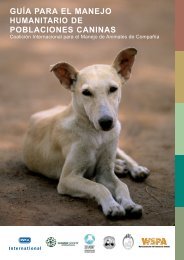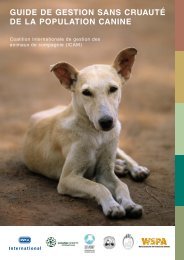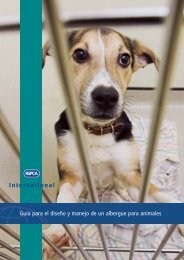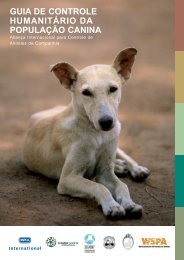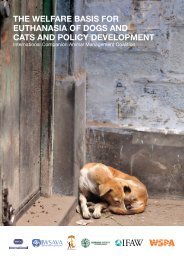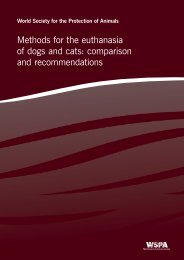HUMANE DOG POPULATION MANAGEMENT GUIDANCE - ICAM ...
HUMANE DOG POPULATION MANAGEMENT GUIDANCE - ICAM ...
HUMANE DOG POPULATION MANAGEMENT GUIDANCE - ICAM ...
Create successful ePaper yourself
Turn your PDF publications into a flip-book with our unique Google optimized e-Paper software.
Euthanasia<br />
When running holding facilities and rehoming centres or<br />
networks, euthanasia will be required for animals that are<br />
suffering from an incurable illness, injury or behavioural<br />
problem that prevents them being rehomed, or are not coping<br />
well enough with the facilities to maintain a reasonable level of<br />
welfare. Ultimately, a successful population management<br />
programme should create a situation where these are the only<br />
occasions when euthanasia is required and all healthy animals<br />
can be found a good home. In reality, however, most countries<br />
will not be able to achieve this situation immediately but will<br />
need to work towards it, accepting that some healthy animals<br />
will be euthanased as not enough homes exist that can<br />
provide a good level of welfare.<br />
Euthanasia deals with only the symptoms and not the causes<br />
of population problems. It will not lead to population<br />
management and must not be relied upon as a sole response.<br />
Whenever euthanasia is used, it must employ humane<br />
methods that ensure the animal moves into unconsciousness<br />
and then death without suffering.<br />
Vaccination and parasite control<br />
Preventative veterinary treatments can be provided to protect<br />
the health and welfare of animals and to reduce the problem<br />
of zoonotic diseases. Rabies vaccinations are usually the<br />
priority issue, but several other diseases can also be<br />
vaccinated against, alongside internal and external parasite<br />
control through appropriate medication. These treatments<br />
should be provided in conjunction with education about<br />
responsible ownership, sterilisation or contraception and<br />
registration and/or identification. The need for vaccination and<br />
parasite control is often well understood by animal owners,<br />
and so offering access to these services may be the easiest<br />
way to entice owners into conversations or agreements about<br />
the other components discussed in this section.<br />
Several issues need to be considered when using this<br />
component.<br />
a. Regular vaccination (especially if covering diseases in<br />
addition to rabies) and parasite control is likely to improve<br />
the health status of individual dogs. Females that were not<br />
previously reproductively successful may become healthy<br />
enough to breed. This does mean that the issue of<br />
increased reproduction needs to be considered and<br />
mitigated as required.<br />
b. As with sterilisation and contraception, preventative<br />
treatments can be used to encourage owners to see the<br />
value of general veterinary treatment and other population<br />
management tools (such as registration and identification),<br />
which are required for the long-term welfare of animals, so<br />
it is worth exploring how to involve the local veterinary<br />
infrastructure in providing preventative treatments. The<br />
provision of preventative treatments for free should be done<br />
with care and according to the local economic situation, as<br />
there is a risk of devaluing general veterinary services if<br />
treatment is provided without cost or understanding of the<br />
extent of cost subsidies.<br />
Fitting a red identification collar to a dog receiving rabies<br />
vaccination and parasite treatment in Sri Lanka.<br />
c. Preventative treatments will need to be provided regularly if<br />
they are to be effective, hence the ease of access to<br />
treatments should be considered.<br />
d. Treatments can be provided via ‘camps’ (temporary, highvolume<br />
treatment sites), which can be very effective at<br />
drawing owners’ attention to the importance of preventative<br />
treatments and other population management tools.<br />
However, the risk of aggressive interactions and disease<br />
transmission between the large number of dogs that will<br />
attend needs to be mitigated by organising access and<br />
exits carefully, using a sterilised needle for each dog, and<br />
quarantining sick animals. Such camps will require<br />
adequate advertising beforehand. There is also a limit to<br />
the distance that the general public will travel for such a<br />
service, so thought must be given to the number of camps<br />
that would be necessary for the desired coverage, and the<br />
associated logistics.<br />
e. Encouraging regular preventative treatments allows for the<br />
diagnosis and treatment of any existing conditions.<br />
Controlling access to resources<br />
Dogs are motivated to roam in public places where there is<br />
access to resources such as food. In order to restrict roaming,<br />
especially in specific areas where dogs are not tolerated (e.g.<br />
schools and public parks), access to these resources needs to<br />
be restricted. This should be done carefully and in conjunction<br />
with measures to reduce the roaming dog population, in order<br />
to avoid dogs starving when food sources are removed or<br />
moving to different areas to find new food sources.<br />
This can be achieved in a number of ways:<br />
a. the regular removal of garbage from homes and public bins<br />
b. the fencing-in of garbage collection and disposal sites<br />
c. the control of offal and carcass disposal<br />
d. the use of animal-proof bins, such as those with heavy lids,<br />
or positioning them out of a dog’s reach<br />
e. education or enforcement measures to stop people littering<br />
(and hence feeding dogs accidentally), and to stop people<br />
purposely feeding dogs in certain areas.<br />
WSPA/ BLUE PAW TRUST<br />
16



